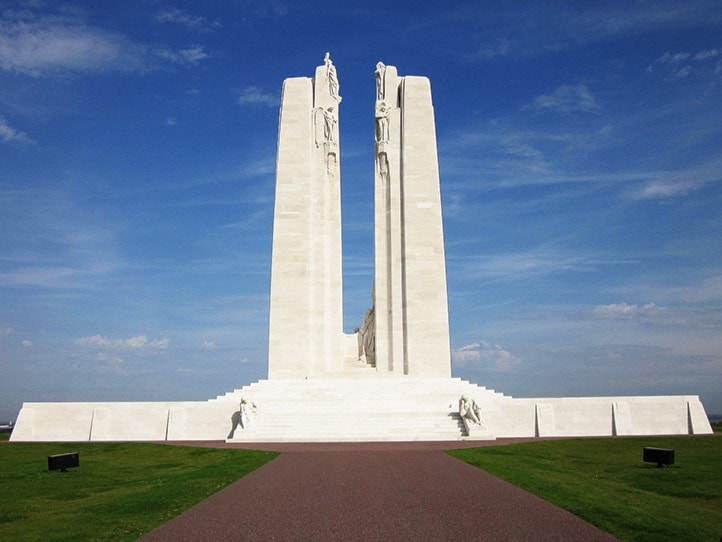In March of 1983 I visited Vimy Ridge in northeastern France. It was a grey, overcast day which threatened rain, or at least a persistent drizzle, at any moment; “dull” is the best word to describe it. That is perhaps only fitting. Vimy Ridge is a place that lends itself to sombre hues; to the muted tones of black-and-white photographs rather than bright sunshine.
No battle looms larger in the Canadian psyche than the battle for Vimy Ridge, which started on April 9, 1917. World War I had been fought for 32 weary months, and Canada had been there since the beginning, although the country had had no say in the matter. As a British colony, Canada was at war in August 1914 because Great Britain was.
Until Vimy Ridge the four divisions of the Canadian Expeditionary Force had not fought together. The ridge, which rises gradually to a height of 476 feet above the Douai Plain, was a strategic stronghold that commanded extensive views of the surrounding countryside, and had been held by the Germans since October 1914, despite numerous British and French attempts to take and hold it.
The battle for Vimy Ridge, in April 1917, was part of the Battle of Arras, and the four Canadian divisions were tasked with taking and holding the ridge. Historians credit the thorough planning and training of the Canadians as key to the success of the battle; the upshot of which was that by April 12, 1917, the Canadians had succeeded in their objective: they took—and held—Vimy Ridge.
The achievement of the Canadian forces was well-recognized. In The British Campaign in France and Flanders: 1917, Sir Arthur Conan Doyle—the creator of Sherlock Holmes—wrote about the Canadian involvement in the Battle of Arras: “We must now turn to the splendid achievement of the Canadian Corps upon the left. The reputation of the Canadians as brilliant soldiers, as dashing in attack as they were steady in defence, had already been solidly established by a long series of military feats … Now the whole might of Canada was drawn together in the four fine divisions which lay facing the historic Vimy Ridge.
“Nothing could have been more magnificent or more successful than their advance … They not only crowned the redoubtable ridge, but they made their way down the eastern slope and established their line beyond it. Many of the German infantry were captured in the great chalk excavations in which they had taken refuge. Incredible incidents happened in these subterranean burrows, where small bodies of Canadian moppers-up were faced suddenly by large numbers of armed Germans in hiding.”
Conan Doyle was not alone in praising the Canadians at Vimy. When news of the Canadian success spread, the New York Tribune published an editorial entitled “Well Done, Canada”. “Every American will feel a thrill of admiration and a touch of honest envy at the achievement of the Canadian troops [America had not yet entered the war] … No praise of the Canadian achievement can be excessive. Canada has sent across the sea an army greater than Napoleon ever commanded in the field.” The New York Times said that the battle for Vimy Ridge would be “in Canada’s history, one of the great days, a day of glory to furnish inspiration to her sons for generations.”

Canadian machine gunners dig themselves into shell holes at Vimy Ridge. Photo courtesy the Dept. of National Defence.
As Pierre Berton has noted, the victory at Vimy was a limited one. “But it was a decisive one, its topography easily understood by civilians. All through the war a ridge of land had barred the way; the Canadians captured that ridge with blinding speed.” And while the idea that Canada “became a nation” after Vimy Ridge did not gain widespread acknowledgement until some years after the war, it was a turning point for many of the men who fought in the battle, who were Canadian soldiers but had been born in Britain, and thought of themselves as more British than Canadian.
That changed, for a good many of them, at Vimy. Frank Worthington, born in Scotland, had spent only nine days in Canada when he enlisted in 1917. “I never felt like a Canadian until Vimy,” he recalled years later. “After that I was a Canadian all the way.”
Canada entered the war as a junior partner of Great Britain, and emerged as an equal. Was this because of Vimy Ridge? Berton asks, “Does it matter? What counts is that in the minds of Canadians, Vimy took on a mythic quality in the post-war years, and Canada was short on myths.”
In 1936, a soaring memorial created by Walter Seymour Allward was unveiled at Vimy Ridge by King Edward VIII. The land on which it sits was ceded by France to Canada for its perpetual use, and is one of only two National Historic Sites of Canada located outside the country (the other is the Beaumont-Hamel Newfoundland Memorial, also in France, and also commemorating World War I).
A light rain did start to fall at Vimy Ridge, that day I visited in 1983, approaching it from a road called Chemin des Canadiens. I walked around the memorial, which commemorates the 7,004 Canadians who were wounded at Vimy, and the 3,598 who died there. One of the names carved on the memorial is that of Ashcroft’s John Christopher Bose, who was 26 when he was killed during a raid on Vimy Ridge on March 1, 1917.
Then the rain stopped, and the sky began to clear, pale sunshine pushing aside the clouds. I looked to the east, and saw a rainbow in the far distance, pale but defiant. I looked from the rainbow to the names carved on the monument and back again at the rainbow, and said a silent “Thank you.” For what, I cannot quite say. But if there is a place, as a Canadian, to give thanks, that place is Vimy Ridge.
